Equipment
Rules and Equipment Regulations
The following Angling Rules and Regulations have been formulated to promote ethical and sportsmanlike angling practices, to establish uniform regulations for the compilation of Australian Gamefish Records and to provide basic angling guidelines for use in fishing tournaments and any other group angling activity.
The word ‘angling’ is defined as catching or attempting to catch fish with a rod, reel, line and hook as outlined in the GFAA Angling Rules and Equipment Regulations. However, there are some aspects of angling that cannot be controlled through rule-making. Angling rules cannot ensure an outstanding performance from each fish and Australian records cannot indicate the amount of difficulty in catching the fish.
Captures in which the fish has not fought or has not had a chance to fight do not reflect credit on the angler, and only the angler can properly evaluate the degree of achievement in establishing the record.
Only fish caught in accordance with GFAA Australian Angling Rules and within the intent of these rules will be considered for Australian records.
Line, Backing, Double, Leader
a) Line
1. Monofilament, multifilament and lead core multifilament lines may be used. For line classes, see Australian Record Requirements.
2. Wire lines are prohibited.
(b) Line and backing
1. The use of backing is permissible.
2. The catch shall be classified under the breaking strength of the line directly preceding the double, leader, and hook. This section must be comprised of a single homogenous piece of line. (For record claims, 16m of the single line must be supplied).
(c) Double line
The use of a double line is not required. If one is used, it must meet the following specifications:
1. A double line must consist of the actual line used to catch the fish.
2. Double lines are measured from the start of the knot, braid, roll or splice making the double to the furthermost end of the knot, splice, snap, swivel or other device used for securing the trace, leader, lure or hook to the double line.
Saltwater species: In all line classes up to and including 10kg (20lb) the double line shall be limited to 4.57m (15ft). The combined length of the double line and leader shall not exceed 6.1m (20ft). The double line on all classes of tackle over 10kg (20lb) shall be limited to 9.14m (30ft). The combined length of the double line and leader shall not exceed 12.19m (40ft).
Freshwater species: The double line on all classes of tackle shall not exceed 1.82m (6ft). The combined length of the double line and the leader shall not exceed 3.04m (10ft).
(d) Leader
The use of a leader is not required. If one is used, it must meet the following specifications: 1. The length of the leader is the overall length, including any lure, hook arrangement
or other device, and is measured to the bend of the last hook.. The leader must be connected to the line with a snap, knot, splice, swivel or other device. Holding devices are prohibited. There are no regulations regarding the material or strength of the leader. Saltwater species: In all line classes up to and including 10kg (20lb) the leader shall be limited to 4.57m (15ft). The combined length of the double line and leader shall not exceed 6.1m (20ft). The leader on all classes of tackle over 10kg (20lb) shall be limited to 9.14m (30ft). The combined length of the double line and leader shall be limited to 12.19m (40ft). Freshwater species: The leader on all classes of tackle shall be limited to 1.82m (6ft). The combined length of the double line and leader shall not exceed 3.04m (10ft).

Rod, Reel
(e) Rod
1. Rods must comply with sporting ethics and customs. Considerable latitude is allowed in the choice of rod, but rods giving the angler an unfair advantage will be disqualified. This rule is intended to eliminate the use of unconventional rods.
2. The rod tip must be a minimum of 101.6cm (40in) in length. The rod butt cannot exceed 68.58cm (27in) in length. These measurements must be made from a point directly beneath the centre of the reel. A curved butt is measured in a straight line. (Above measurements do not apply to surf-casting rods.)
(f) Reel
1. Reels must comply with sporting ethics and customs.
2. Power-driven reels of any kind are prohibited. This includes motor, hydraulic or electrically driven reels and any device that gives the angler an unfair advantage.
3. Ratchet handle reels are prohibited.
4. Reels designed to be cranked with both hands at the same time are prohibited.
Hooks for fishing with natural bait
g) Hooks for fishing with natural bait
1. For live or deadbait fishing no more than two single hooks may be used. Both must be firmly imbedded in or securely attached to the bait. The eyes of the hooks must be no less than a hook’s length (the length of the largest hook used) apart and no more than 45.72cm (18in) apart. The only exception is that the point of one hook may be passed through the eye of the other hook.
2. The use of a dangling or swing hook is prohibited. Double and treble hooks are prohibited.
3. A two-hook rig for bottom fishing is acceptable if it consists of two single hooks on separate leaders or drops. Both hooks must be imbedded in the respective baits and separated sufficiently so that a fish caught on one hook cannot be foul-hooked by the other.
4. All record applications made for two-hook tackle must be accompanied by a photograph or sketch of the hook arrangement.
5. A lure may be used in conjunction with a natural bait, provided the hook satisfies the requirements of hooks for fishing with natural baits (g) & the lure touches the bait during normal fishing/trolling practices. The hook must NOT precede the bait or bait/lure combo by more than the length of the hook
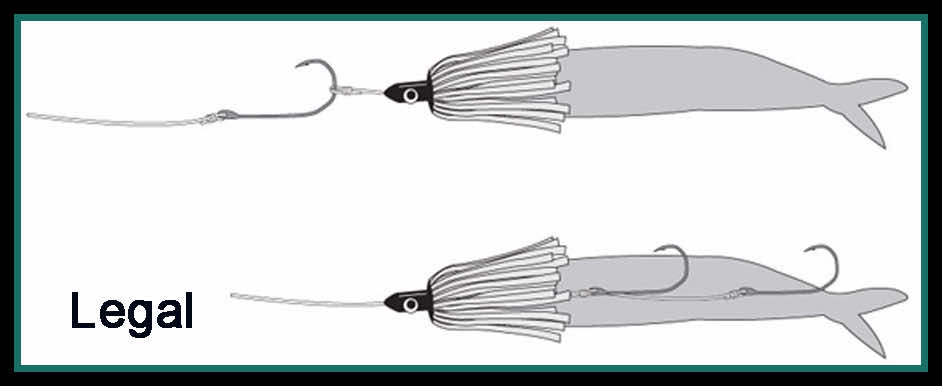

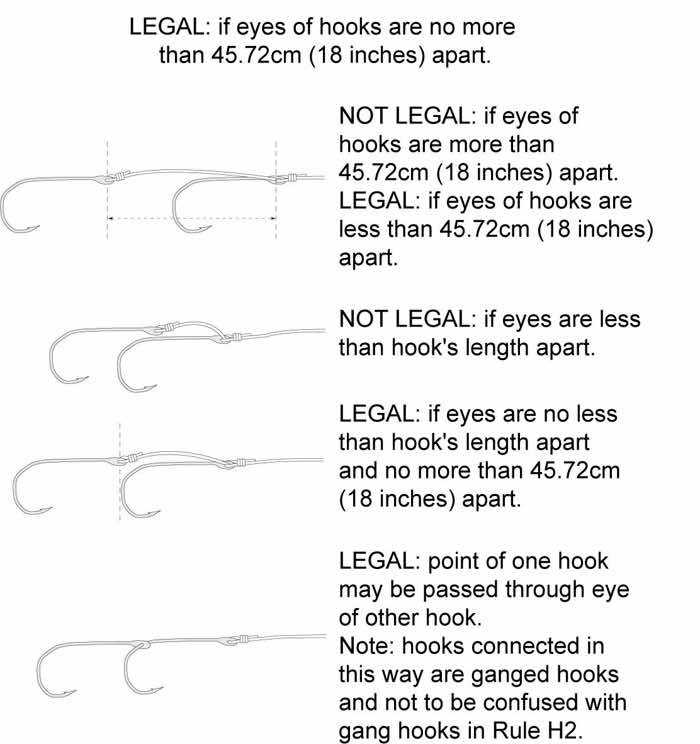

Hooks and Lures
(h) Hooks and lures
When using an artificial lure with a skirt or trailing material:
1. no more than two single hooks may be attached to the line, leader or trace. The hooks need not be attached separately. The eyes of the hook must be no less than an overall hook’s length (overall length of the largest hook used) apart and no more than 30.48cm (12in) apart. The only exception is that the point of one hook may be passed through the eye of the other hook. The trailing hook may not extend more than a hook’s length beyond the skirt of the lure. A photograph or sketch showing the hook arrangement must accompany the record application.
Clarification: If a hook is cut, then the length of the hook will be deemed to be to the cut – anything beyond the cut will be deemed as leader. See Illustration 01.
2. Gang (double or treble) hooks are permitted when attached to plugs and other artificial lures that are specifically designed for this use. Gang hooks must be free-swinging and shall be limited to a maximum of three hooks (either single, double or treble, or a combination of any three). Bait may not be used with gang hooks.
3. Assist hooks or other such single hooks that are attached to a lure with a lead constructed of monofilament, multifilament, wire or other such material must conform to the following: When using assist hooks on any artificial lure, other than a skirted lure, the lead cannot be more than 11/2 hook’s length and the bend of the hook must not be more than 4 inches (101mm), whichever is less from the closest point of attachment on the lure.
Double and treble hooks may not be used as assist hooks. See Illustration 02.
A photograph or sketch of the plug or lure must be submitted with record applications.
A gang hook in the intent of this rule is a hook with two or more prongs (i.e.: multi-pointed hook, not to be confused with ganged hooks as per diagram in Rule G1).
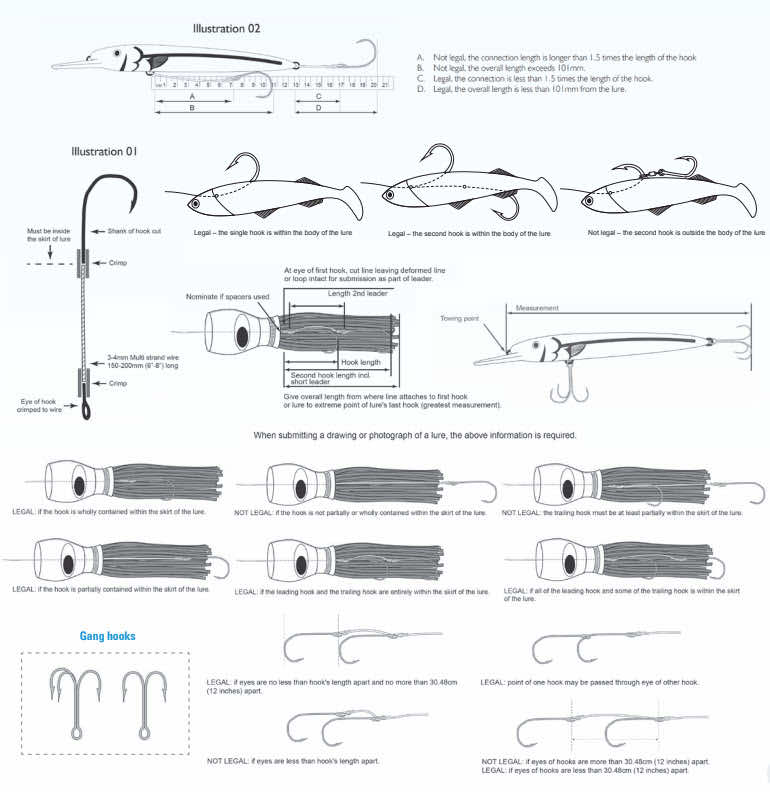

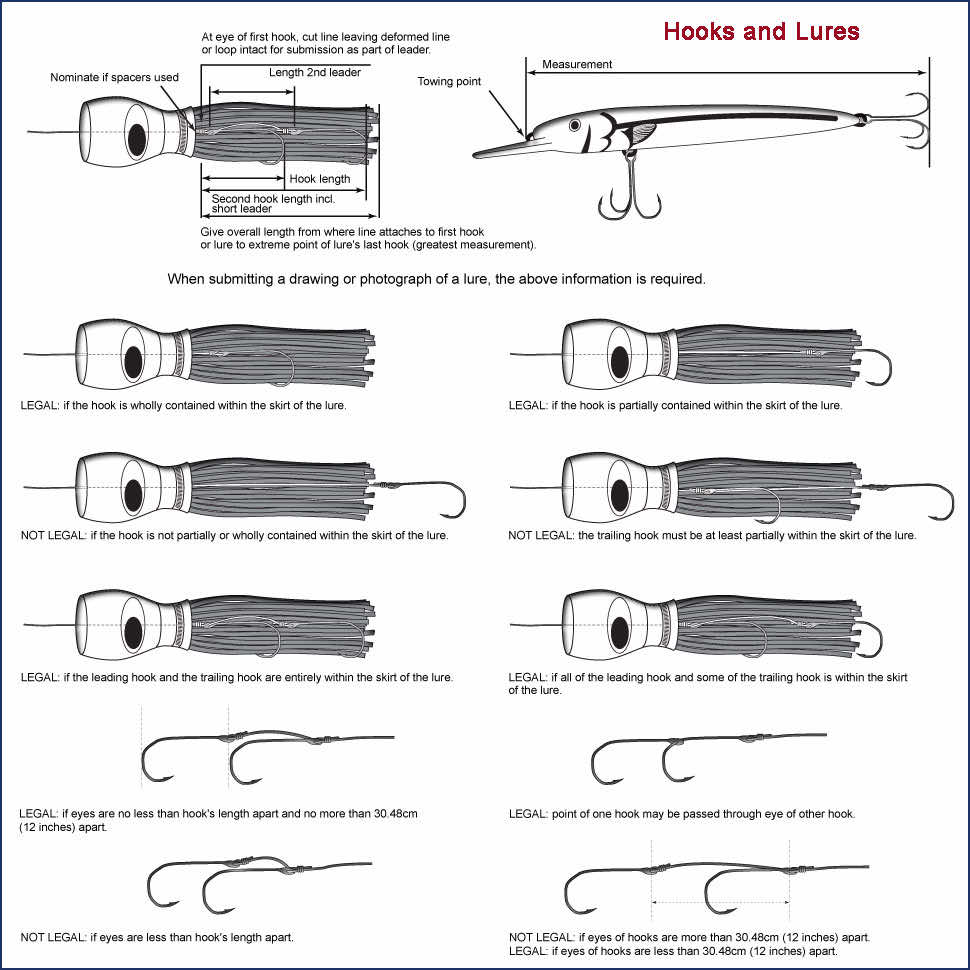
Illustration 02


Other Equipment
(i) Other equipment
1. Fighting chairs may not have any mechanical propelled devices that aid the angler in fighting a fish.
2. Gimbals must be free-swinging, which includes gimbals that swing in a vertical plane only. Any gimbal that allows the angler to reduce strain or to rest while fighting the fish is prohibited.
3. Gaffs and nets used to boat or land a fish must not exceed 2.44m (8ft) in overall length. (When fishing from a bridge, pier, or other high platform or structure, this length limitation does not apply.) In using a flying or detachable gaff, the rope may not exceed 9.14m (30ft). The gaff rope must be measured from the point where the rope is secured to the detachable head to the other end. Only the effective length will be considered. If a fixed head gaff is used, the same limitation shall apply and the gaff rope shall be measured from the same location on the gaff hook. Only a single hook is permitted on any gaff. Harpoon or lance attachments are prohibited. Tail ropes are limited to 9.14m (30ft).
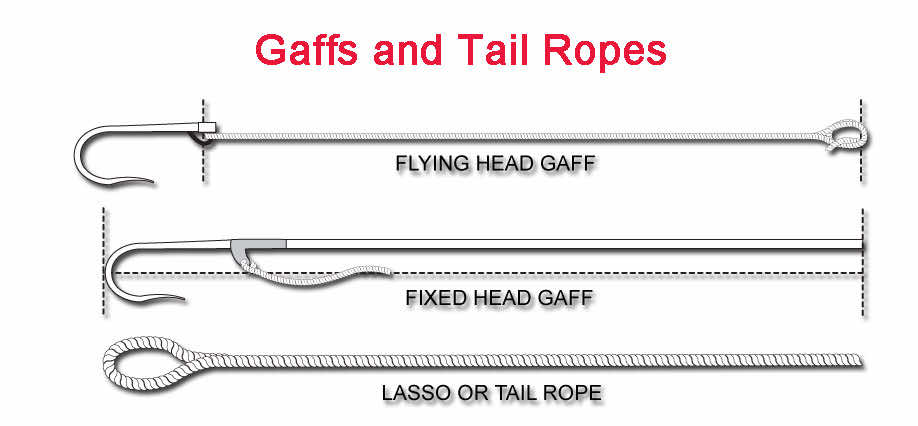
4. Floats are prohibited with the exception of any small flotation device attached to the line or leader for the sole purpose of regulating the depth of the bait. The flotation device must not in any way hamper the fighting ability of the fish.
5. Entangling devices (either with or without a hook) are prohibited and may not be used for any purpose, including baiting, hooking, fighting, or landing the fish.
6. Outriggers, downriggers and kites are permitted provided that the actual fishing line is attached to the snap or other release device, either directly or with some other material. The leader or double line may not be connected to the release mechanism, either directly or with the use of connecting device.
7. Any devices used in conjunction with a lure that could impede the fighting ability of the fish MUST be on a breakaway system.
8. A safety line may be attached to the rod, reel or harness provided that it does not in any way assist the angler in fighting the fish.
